TN State Board 12th Physics Important Questions Chapter 5 Electromagnetic Waves
Question 1.
State Maxwell’s modified form of Ampere’s j law.
Answer:
\(\overrightarrow{\mathbf{B}} \cdot d \vec{s}\) = µ0 I = µ0 (Ic + Id)
Where Ic – conduction current
Id – displacement current
Question 2.
Which one of Maxwell’s equations contains source of electric field?
Answer:
(i) \(\oint \overrightarrow{\mathrm{E}} \cdot d \vec{s}=Question / \varepsilon_{0}\)
(ii) \(\oint \mathrm{E} \cdot d \vec{l}=-\frac{d}{d t} \int \overrightarrow{\mathrm{B}} \cdot d s\)
![]()
Question 3.
Which one of Maxwell’s equations contains j source of magnetic field?
Answer:
\(\oint \overrightarrow{\mathrm{B}} \cdot d s=0\)
Question 4.
Light can travel in vacuum whereas sound cannot do so. Why?
Answer:
Light, being an electromagnetic wave do not require any material medium for its propagation. So, light can travel in vacuum. On the other hand, sound is a mechanical wave. It requires a medium for its propagation. Hence sound cannot travel through vacuum.
Question 5.
What physical quantity is same for X-rays and radio waves?
Answer:
Speed of light in vacuum is same for X-rays and radio waves.
![]()
Question 6.
What is the dimension of (ε0 μ0)?
Answer:
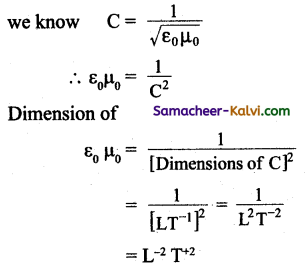
Question 7.
Which waves are used to transmit voice communication?
Answer:
Radio waves
Question 8.
Name the wave that is used in heat therapy for sprain?
Answer:
Infra red rays
![]()
Question 9.
State the rays that a re used for the treatment of cancer and tumour?
Answer:
Gamma rays
Question 10.
Alame the line absorption spectrum found in solar spectrum.
Answer:
Fraunhofer lines.
Question 11.
Explain integral form of Faraday’s law of electromagnetic Induction.
Answer:
Faraday’s law of electromagnetic induction. This law relates electric field with the changing magnetic flux which is mathematically written as
\(\oint \overrightarrow{\mathrm{E}} \cdot d \vec{l}=-\frac{d}{d t} \phi_{\mathrm{B}}\) (Faraday’s law)
where E is the electric field. This equation implies that the line integral of the electric field around any closed path is equal to the rate of change of magnetic flux through the closed path bounded by the surface.
![]()
Question 12.
Obtain the expression for the energy density of an electromagnetic wave.
Answer:
The energy density (energy per unit volume) associated with an electromagnetic wave propagating in vacuum or free space is
u = ε0E2 + \(\frac{1}{2 \mu_{0}}\) B2
where, \(\frac{1}{2}\)ε0E2 = uE is the energy densityin an electric field and \(\frac{1}{2 \mu_{0}}\) B2 = uB is the energy density in a magnetic field.
Since, E = BC ⇒ uB = uE
The energy density of the electromagnetic wave is
u = ε0E2 = \(\frac{1}{\mu_{0}}\) B2
Question 13.
How will you calculate the momentum delivered to the surface?
Answer:
If the incident electromagnetic wave of energy U is totally reflected from the surface, then the momentum delivered to the surface is
∆p = \(\frac{U}{C}-\left(-\frac{U}{C}\right)=2 \frac{U}{C}\)
Question 14.
What is spectrum?
Answer:
The image obtained in the field of view of the telescope consists of a number of coloured images of the slit. Such an image is called a spectrum.
![]()
Question 15.
What is spectrum of sodium?
Answer:
If the slit is illuminated with light from sodium vapour lamp, two images of the slit are obtained in the yellow region of the spectrum. These images are the emission lines of sodium having wave lengths 5896 Å and 5890 Å. This is known as spectrum of sodium.
Question 16.
How are electromagnetic waves classified?
Answer:
The spectra obtained from different bodies can be classified into two types:
- emission spectra and
- absorption spectra.
Question 17.
What are emission and absorption spectra?
Answer:
Emission spectrum:
When the light emitted by a source is directly examined with a spectrometer, the emission spectrum is obtained.
Absorption spectrum:
When the light emitted . by a source is made to pass through an absorbing material and then examined with a spectrometer, the absorption spectrum is obtained.
![]()
Question 18.
What are the uses of Infra red waves?
Answer:
- Infra red lamps are used in physiotherapy.
- Infra red photographs are used in weather forecasting.
- As infra red radiations are not absorbed by air, thick fog, mist, etc., they are used to take photograph of long distance objects.
- Infra red absorption spectrum is used to study the molecular structure.
Question 19.
What are the uses of ultraviolet radiation?
Answer:
- They are used to destroy the bacteria and for sterilizing surgical instruments.
- These radiations are used in detection of forged documents, finger, prints in forensic laboratories.
- They are used to preserve the food items.
- They help to find the structure of atoms.
![]()
Question 20.
Explain the integral form of maxwell’s equations briefly.
Answer:
(i) First equation is nothing but the Gauss’s law. It relates the net electric flux to net electric charge enclosed in a surface. Mathematically, it is expressed as
\(\oint \overrightarrow{\mathrm{E}} \cdot d \overrightarrow{\mathrm{A}}=\frac{\mathrm{Q}_{\text {enclosed }}}{\varepsilon_{0}}\) (Gauss’s law) ……………(1)
where \(\vec{E}\) is the electric field and Qenclosed is the charge enclosed. This equation is true for both discrete or continuous distribution of charges. It also indicates that the electric field lines start from positive charge and terminate at negative charge. This implies that the electric field lines do not form a continuous closed path. In other words, it means that isolated positive charge or negative charge can exist.
(ii) Second equation .has no name. But this law is similar to Gauss’s law in electrostatics. So this law can also be called as Gauss’s law in magnetism. The surface integral of magnetic field over a closed surface is zero. Mathematically,
\(\oint \mathrm{B} \cdot d \overrightarrow{\mathrm{A}}\) = 0 (No name) …………..(2)
where \(\vec{B}\) is the magnetic field.
This equation implies that the magnetic lines of force form a continuous closed path. In other words, it means that no isolated magnetic monopole exists.
This equation implies that the magnetic lines of force form a continuous closed path. In other words, it means that no isolated magnetic monopole exists.
(iii) Third equation is Faraday’s law of electromagnetic induction. This law relates electric field with the changing magnetic flux which is mathematically written as
\(\oint \overrightarrow{\mathrm{E}} \cdot d \vec{l}=-\frac{d}{d t} \phi_{\mathrm{B}}\) (Fraday’s law) …………(3)
where \(\vec{E}\) is the electric field. This equation implies that the line integral of the electric field around any closed path is equal to the rate of change of magnetic flux through the closed path bounded by the surface. Our modem technological revolution is due to Faraday’s laws of electromagnetic induction. The electrical energy supplied to our houses from , electricity board by using Faraday’s law of induction.
(iv) Fourth equation is modified Ampere’s circuital law. This is also known as Ampere – Maxwell’s law. This law relates the magnetic field around any closed path to the conduction current and displacement current through that path.
\(\oint \vec{B} \cdot d \vec{l}=\mu_{0} I_{e n c l o s e d}+\mu_{0} \varepsilon_{0} \frac{d}{d t} \int_{s} \vec{E} \cdot d \overrightarrow{\mathrm{A}}\) (Ampere-Maxwell’s law)
where \(\vec{B}\) is the magnetic field. This equation shows that both conduction and also displacement current produces magnetic field. These four equations.
![]()
Question 21.
With the help of an experiment, explain the method of generation of magnetic field by changing electric field.
Answer:
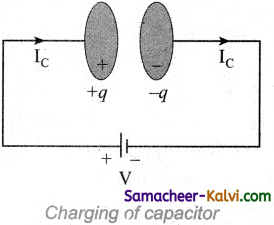
In order to understand how the changing electric field produces magnetic field, let us consider a situation of ‘charging a parallel plate capacitor. Assume that the medium in between the capacitor plates is a non-conducting medium.
The electric current passing through the wire is the conduction current Ic. This current generates magnetic field around the wire connected across the capacitor. Hence when a magnetic needle is kept near the wire,
deflection is observed. In order to compute the strength of magnetic field at a point, Let us use a Ampere’s circuital law that states that ‘the line integral of the magnetic field B around any closed loop is equal to p0 times the net current I threading through the area enclosed by the loop’. Ampere’s law in equation form is
\(\oint_{1} \vec{B} \cdot d l=\mu_{0} \mathrm{I}(t)\)
where µ0 is the permeability of free space.
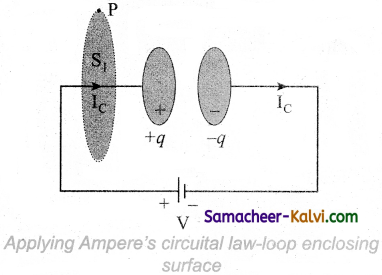
![]()
Question 22.
Explain briefly (i) Infra red rays, (ii) Ultra violet rays, (iii) Gamma rays.
Answer:
(i) Infra red rays:
It is produced from hot bodies and also when the molecules undergo rotational and vibrational transitions. The wavelength range is 8 × 10-7 m to 5 × 10-3 m and frequency range are 4 × 1014 Hz to 6 × 1010 Hz. It provides electrical energy to satellites by means of solar cells. It is used to produce dehydrated fruits, in green houses to keep the plants warm, heat therapy for muscular pain or sprain, TV remote as a signal carrier, to look through haze fog or mist and used in night vision or infrared photography.
(ii) Ultra violet rays:
It is produced by Sun, arc and ionized gases. The wavelength range is 6 × 10-10 m to 4 × 10-7 m, and frequency range are 5 × 1017 Hz to 7 × 1014 Hz. It has less penetrating power. It can be absorbed by atmospheric ozone and harmful to human body. It is usedto destroy bacteria, sterilizing the surgical instruments, burglar alarm, detect the invisible writing, finger prints and also in the study of molecular structure.
(iii) Gamma rays:
It is produced by transitions of atomic nuclei and decay of certain elementary particles. They produce chemical reactions on photographic plates, fluorescence, ionisation, diffraction. The wavelength range is 1 × 10-14 m to 1 × 10-10 m and frequency range are 3 × 1022 Hz to 3 × 1018 Hz. Gamma rays have high penetrating power than X-rays and ultraviolet radiations; it has no charge but harmful to human body. Gamma rays provide information about the structure of atomic nuclei. It is used in radio therapy for the treatment of cancer and tumour, in food industry to kill pathogenic microorganism.
Question 23.
Explain black body radiation spectrum th the help of a diagram.
Answer:
When an object burns, it emits colours. That is, it emits electromagnetic radiation which depends on temperature. If the object becomes hot then it glows in red colour. If the temperature of the object is further increased then it glows in reddish-orange colour and becomes white when it is hottest.
refer figure P.No. 257,
The spectrum in usually called as black body spectrum. It is a continuous frequency (or wavelength) curve and depends on the body’s temperature.
Question 24.
In a medium dielectric constant 5, the maximum displacement current is equal to the maximum coduction current at a frequency of 1 MHz, the calculate the conductivity of the medium.
Answer:
Frequency f = 1 MHz = 1 × 106 Hz
Permittivity in free space ε0 = 8.85 10-12
Permittivity in a medium ε = εrε0
Relative permittivity εr = 5
Angular frequency ω = 2πf
Conductivity σ = εω
∴ σ = 2π × 1 × 106 × εrε0
= 2 × 3.14 × 1 × 106 × 5 × 8.85 × 10-12
= 2.78 × 10-4 Ω-1 m-1
![]()
Question 25.
An LC resonant circuit contains a capacitor 400 pF and an inductor 100 µH. It is sent into oscillations coupled to an antenna. Calculate the wavelength of the radiated electromagnetic wave.
Answer:
Capacitance C = 400 × 10-12 F;
Inductance L = 100 × 10-6 H;
Frequencyu = \(\frac{1}{2 \pi \sqrt{\mathrm{LC}}}\);
Wavelength λ = \(\frac{\mathrm{C}}{v}\)
Frequency
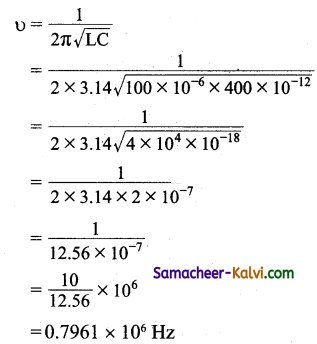
Wavelength λ = \(\frac{C}{v}=\frac{3 \times 10^{8}}{0.7961 \times 10^{6}}\)
= \(\frac{3 \times 10^{8-6}}{0.7961}\)
= 376.83 m = 377 m
wavelength = 377 m.
Question 26.
A monochromatic light of wavelength 589 nm is incident on a water surface having refractive index 1,33. Find the velocity, frequency and wavelength of light in water.
Answer:
Wavelength λ = 589 × 10-9 m;
Refractive index µ = 1.33
µ = \(\frac{\mathrm{C}_{\text {air }}}{\mathrm{C}_{\text {water }}}\)
∴ Cwater = \(\frac{C_{a i r}}{\mu}\)
Frequency υ = \(\frac{\mathrm{C}_{\text {water }}}{\lambda}\)
Velocity of light in water,
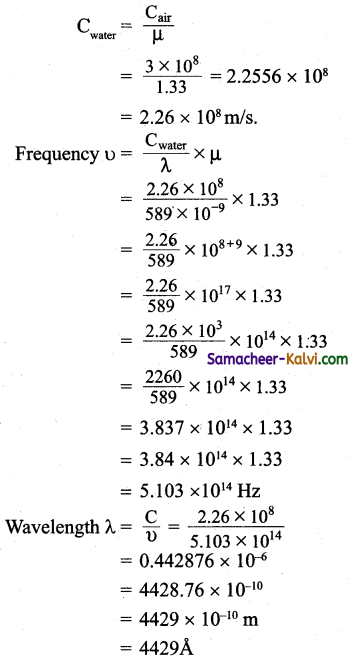
Velocity of light in water = 2.26 × 108 m/s
Frequency of light in water = 5.103 × 1014 Hz
Wavelength of light in water = 4429 Å
![]()
Question 27.
Electromagnetic wave with an energy flux of 40 Wm-2 is incident on a non-conducting surface. If the area of the surface is 10 m-2 then calculate the force exerted on the surface in a time interval of 30 minutes.
Answer:
Energy flux = 40 W m-2
Area of the surface A = 10 × m2 = 10 m2
Time = 30 × 60 = 1800 s
Total energy incident on the surface U = Energy flux × surface area x (Time)2
Total energy
U= 40 × 10 × 1800
= 72 × 104
= 7.2 × 105 J
Velocity of light C = 3 × 108 m/s
Momentum P = \(\frac{\mathrm{U}}{\mathrm{C}}=\frac{7.2 \times 10^{5}}{3 \times 10^{8}}\)
= 2.4 × 10-3 kg ms-1
∴ Force exerted F = \(\frac{\mathrm{P}}{t}\)
= \(\frac{2.4 \times 10^{-3}}{1800}\)
= \(\frac{24 \times 10^{-4-2}}{18}\) = \(\frac{4}{3}\) × 10-6
Force F = 1.33 × 10-6 N
Question 28.
When a parallel plate capacitor of capacitance 2 µF is charged by a time varying voltage, then an instantaneous displacement current of 1.5 A is set up in between the plates. Then calculate the value of the rate of voltage.
Answer:
Capacitance C = 2 µF = 2 × 10-6
Current Id = 1.5 A
Current = \(\frac{\text { Charge }}{\text { Time }}\)
I = \(\frac{\mathrm{Q}}{t}\) But Question = CV
∴ Id = \(\frac{\mathrm{CV}}{t}\)
∴ \(\frac{V}{t}=\frac{I_{d}}{C}=\frac{1.5}{2 \times 10^{-6}}\) = 0.75 × 106 v/s
Rate of voltage = \(\frac{V}{t}\) = 0.75 × 106 v/s
![]()
Question 29.
If a capacitor of 2 µF is charged to 20 V and than suddenly short-circuted by a coil of negligible resistance and of inductance 8 µH. Calculate
(i) amplitude of oscillatory current and
(ii) frequency of resulting current oscillation.
Answer:
Capacitance C= 2 × 10-6 F
Potential E = 20 V
Inductance L = 8 × 10-6 H
(i) The equation for the oscillatory discharge of capacitor through an inductance is given by
Question = q0 sin ωt
ω = \(\frac{1}{\sqrt{\mathrm{Lc}}}\)
∴ The resulting oscillatory current I = \(\frac{d q}{d t}\)
= q0 ω cos ω0t = I0 cos ωt
Amplitude of oscillatory
Current I = \(\frac{d q}{d t}\)
I = q0 ω
= CE \(\frac{1}{\sqrt{\mathrm{Lc}}}\)
= E \(\sqrt{\frac{\mathrm{C}}{\mathrm{L}}}\)
I = 20\(\sqrt{\frac{2 \times 10^{-6}}{8 \times 10^{-6}}}\)
= 20 × \(\frac{1}{2}\) = 10 A
∴ Amplitude of resulting current = 10 A
(ii) Frequency of resulting current oscillation
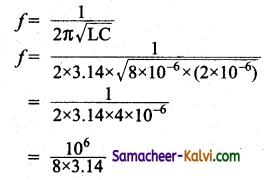
Frequency = 4 × 104 Hz
Frequency of the resulting oscillations f = 4 × 104 Hz.
![]()
Question 30.
The wavelength of an electromagnetic wave is 6 mm. The electric field in the y direction and its maximum amplitude is 33 Vm-1 write the equation for electric and magnetic fields as a function of x and t.
Answer:
Wavelength λ = 6mm = 6 × 10-3 m
Electric field E0 = 33 Vm-1
Magnetic field B0 = \(\frac{E_{0}}{C}\)
Angular frequency ω0 = 2πυ
ω = 2π × \(\frac{C}{\lambda}\)
[∵ C = 3 × 108 m/s]
ω = 2 × 3.14 × \(\frac{3 \times 10^{8}}{6 \times 10^{-3}}\)
= 3.14 × 1011 rad/s
∴ The amplitude of magnetic field B0 = \(\frac{E_{0}}{C}\)
B0 = \(\frac{33}{3 \times 10^{8}}\)
= 11 × 10-8 T
The equation for the electric field along y – axis in the electromagnetic wave is
Ey = E0 sin ω (t – \(\frac{x}{c}\))
Ey = 33 sin π × 1011 (t – \(\frac{x}{c}\))
In the electromagnetic wave the equation for the magnetic field is
B2 = B0 sin ω (t – \(\frac{x}{c}\))
B2 = 11 × 10-8 × sin π × 1011 (t – \(\frac{x}{c}\))
![]()
Multiple Choice Questions:
Question 1.
A magnetic field is generated by:
(a) a moving charge
(b) a changing electric field
(c) a changing electric field of moving charge
(d) a changing magnetic flux
Answer:
(c) a changing electric field of moving charge
Question 2.
Any change in electric field with time at a point produces ………. at that point.
(a) an electric field
(b) a magnetic field
(c) a gravitational field
(d) both (a) and (c)
Answer:
(b) a magnetic field
Question 3.
Unpolarised light passes through a tourmaline crystal. The emergent light is analysed by j an analyser. When the analyser is rotated through 90°, the intensity of light:
(a) remains uniformly bright
(b) remains uniformly dark
(c) varies between maximum and minimum
(d) varies between maximum and zero.
Answer:
(d) varies between maximum and zero.
Question 4.
Electromagnetic theory was proposed by:
(a) Newton
(b) Huygen
(c) Maxwell
(d) Planck
Answer:
(c) Maxwell
Question 5.
Experimental verification of electromagnetic theory was done by:
(a) Hertz
(b) James Clerk
(c) Maxwell
(d) Huygen
Answer:
(a) Hertz
![]()
Question 6.
Velocity of the electromagnetic waves through vacuum is:
(a) \(\sqrt{\mu_{0} \dot{\varepsilon}_{0}}\)
(b) \(\frac{1}{\sqrt{\mu_{0} \varepsilon_{0}}}\)
(c) \(\sqrt{\frac{\mu_{0}}{\varepsilon_{0}}}\)
(d) \(\sqrt{\frac{\varepsilon_{0}}{\mu_{0}}}\)
Answer:
(b) \(\frac{1}{\sqrt{\mu_{0} \varepsilon_{0}}}\)
Question 7.
The charge of the electromagnetic wave is:
(a) positive
(b) negative
(c) nil
(d) infinity
Answer:
(c) nil
Question 8.
In an electromagnetic wave, the electric field is
(a) in the direction of electromagnetic wave
(b) parallel to the direction of electromagnetic wave
(c) perpendicular to the direction of electromagnetic wave
(d) zero
Answer:
(c) perpendicular to the direction of electromagnetic wave
Question 9.
If the velocity of light in a medium is 2.25 × 108 ms-1 then the refractive index of the medium will be:
(a) 1.5
(b) 0.5
(c) 1.33
(d) 1.73
Answer:
(c) 1.33
Question 10.
Assertion:
Light can travel in vacuum but sound cannot travel in vacuum.
Reason:
Light is an electromagnetic wave whereas sound is a mechanical wave.
Which one of the following statement is correct?
(a) Both assertion and reason are true and reason explains assertion correctly,
(b) Both assertion and reason are true and reason does not explain assertion correctly.
(c) Assertion is true but reason is false.
(d) Assertion is false but reason is true.
Answer:
(a) Both assertion and reason are true and reason explains assertion correctly.
![]()
Question 11.
Assertion:
In an electromagnetic wave the direction of magnetic field is perpendicular to the eleciric field \(\vec{E}\).
Reason:
Electric field vector \(\vec{E}\) and magnetic field vector \(\vec{B}\) have same frequency.
Which one of the following statement is correct?
(a) Both assertion and reason are true and reason explains assertion correctly.
(b) Both assertion and reason are true and reason does not explain assertion correctly.
(c) Assertion is true but reason is false.
(d) Assertion is false but reason is true.
Answer:
(c) Assertion is true but reason is false.
Question 12.
Assertion:
A changing electric field produces magnetic field.
Reason:
A changing magnetic field produces electric field.
Which one of the following statement is correct?
(a) Both assertion and reason are true and reason explains assertion correctly.
(b) Both assertion and reason are true and reason does not explain assertion correctly.
(c) Assertion is true but reason is false.
(d) Assertion is false but reason is true.
Answer:
(b) Both assertion and reason are true and reason does not explain assertion correctly.
Question 13.
Assertion:
Magnetic field lines cannot start from a point nor end at a point.
Reason:
The line integral of magnetic field over a closed path is not zero.
Which one of the following statement is correct?
(a) Both assertion and reason are true and reason explains assertion correctly.
(b) Both assertion and reason are true and reason does not explain assertion correctly.
(c) Assertion is true but reason is false.
(d) Assertion is false but reason is true.
Answer:
(c) Assertion is true but reason is false.
![]()
Question 14.
Which one of the following is correct statement?
(a) \(\oint \overrightarrow{\mathrm{B}} d \vec{l}\) can expressed in coulomb
(b) \(\oint \frac{\overrightarrow{\mathrm{B}}}{\mu_{0}} \cdot d \vec{s}\) can expressed in coulomb
(c) \(\oint \overrightarrow{\mathrm{E}} \cdot d \vec{l}\) can expressed in coulomb
(d) \(\oint \varepsilon_{0} \overrightarrow{\mathrm{E}} \cdot d \vec{s}\) can expressed in coulomb
Answer:
(c) \(\oint \overrightarrow{\mathrm{E}} \cdot d \vec{l}\) can expressed in coulomb
Question 15.
Select the odd man out:
(a) \(\frac{\phi}{I}\)
(b) \(\frac{-e}{d \mathrm{~L} / d t}\)
(c) \(\frac{1}{\sqrt{\mu_{0} \varepsilon_{0}}}\)
(d) \(\frac{\mu_{0} \mathrm{~N}^{2} \mathrm{~A}}{b}\)
Answer:
(c) \(\frac{1}{\sqrt{\mu_{0} \varepsilon_{0}}}\)
Question 16.
In which one of the following velocity of light will be maximum?
(a) Glass
(b) Water
(c) Diamond
(d) Vacuum
Answer:
(d) Vacuum
Question 17.
If L is the inductance and C is the capacitance then the frequency for oscillation of charges:
(a) υ = \(\frac{1}{\pi \sqrt{\mathrm{LC}}}\)
(b) υ = \(\frac{1}{2 \pi \mathrm{LC}}\)
(c) υ = \(\frac{1}{2 \pi(\mathrm{L} / \mathrm{c})}\)
(d) υ = \(\frac{1}{2 \pi \sqrt{L C}}\)
Answer:
(d) υ = \(\frac{1}{2 \pi \sqrt{L C}}\)
![]()
Question 18.
In Raman effect the incident photon makes collision with an excited molecule of the substance. The scattered photon gives rise to:
(a) Stokes’ line
(b) Anti-Stokes’ line
(c) Rayleigh line
(d) Zeeman line
Answer:
(b) Anti-Stokes’ line
Question 19.
The physical properties of electromagnetic waves are not determined by:
(a) wavelength
(b) material
(c) frequency
(d) method of excitation
Answer:
(d) method of excitation
Question 20.
Radio waves, microwaves, infrared spectrum, ultraviolet rays, X-rays and gamma rays are classified as:
(a) light waves
(b) electromagnetic waves
(c) electric waves
(d) magnetic waves
Answer:
(b) electromagnetic waves
Question 21.
Visible spectrum lies between:
(a) radio waves and microwaves
(b) infrared spectrum and ultraviolet rays
(c) microwaves and infrared spectrum
(d) X-rays and gamma rays
Answer:
(b) infrared spectrum and ultraviolet rays
![]()
Question 22.
The wavelength range of microwaves is from:
(a) 0.03 m- 10-3 m
(b) 0.3 m- 10-3 m
(c) 3 m- 10-5 m
(d) 30 m- 10-6 m
Answer:
(b) 0.3 m- 10-3 m
Question 23.
Waves from two coherent sources interfere with each other. At a point where the trough of one wave superposes with the trough of the other wave the intensity of light is:
(a) maximum
(b) minimum
(c) zero
(d) no change
Answer:
(a) maximum
Question 24.
The frequency range of gamma rays is from:
(a) 3 × 1017 Hz to 5 × 1019 Hz
(b) 1 × 1016 Hz to 3 × 1022 Hz
(c) 3 × 1011 Hz to 4 × 1014 Hz
(d) 3 × 109 Hz to 3 × 1011 Hz
Answer:
(b) 1 × 1016 Hz to 3 × 1022 Hz
Question 25.
The frequency range of infrared rays is from:
(a) 3 × 10-11 Hz to 4 × 10-14 Hz
(b) 1 × 1013 Hz to 4 × 1014 Hz
(c) 3 × 10-11 Hz to 40 × 1014 Hz
(d) 3 × 1011 Hz to 40 × 1014 Hz
Answer:
(b) 1 × 1013 Hz to 4 × 1014 Hz
Question 26.
Light waves:
(a) can travel in perfect vacuum
(b) require air to travel through
(c) require an electric field to travel through
(d require a magnetic field to travel through
Answer:
(a) can travel in perfect vacuum
![]()
Question 27.
Which of the following is used to find structure of atoms?
(a) IR
(b) UV
(c) visible light
(d) microwave
Answer:
(b) UV
Question 28.
The idea of displacement current was proposed by:
(a) Ampere
(b) Maxwell
(c) Gauss
(d) Faraday
Answer:
(b) Maxwell
Question 29.
The radiations used in physiotherapy are:
(a) ultraviolet
(b) infrared
(c) radiowaves
(d) microwaves
Answer:
(b) infrared
Question 30.
The nature of the wavefront corresponding to extraordinary ray inside a calcite crystal is:
(a) plane
(b) spherical
(c) elliptical
(d) cylindrical
Answer:
(c) elliptical
![]()
Question 31.
A line spectrum identifies a:
(a) solid
(b) liquid
(c) gas
(d) None of above
Answer:
(c) gas
Question 32.
The spectrum produced by a substance in molecular state is known as:
(a) line spectrum
(b) continuous spectrum
(c) band spectrum
(d) pure spectrum
Answer:
(c) band spectrum
Question 33.
A large number of dark lines in the solar spectrum are:
(a) Fraunhofer lines
(b) Fresnel lines
(c) Stokes lines
(d) Antistokes lines
Answer:
(a) Fraunhofer lines
Question 34.
In a plane transmission grating the width of a ruling is 12000 A and the width of a slit is 8000 A the grating element is
(a) 20 µm
(b) 2 µm
(c) 200 µm
(d) 10 µm
Answer:
(b) 2 µm
![]()
Question 35.
The spectrum produced by a substance in molecular state is known as:
(a) line spectrum
(b) continuous spectrum
(c) band spectrum
(d) pure spectrum
Answer:
(c) band spectrum
Question 36.
The correct definition of spectrum is:
(a) band of wavelength
(b) band of colours
(c) band of frequencies
(d) band of amplitudes
Answer:
(a) band of wavelength
Question 37.
Line spectrum is obtained from:
(a) sodium vapour lamp
(b) molecules
(c) carbon arc
(d) solids
Answer:
(a) sodium vapour lamp
Question 38.
The line spectra is due to:,
(a) molecules in the gaseous state
(b) molecules in the liquid state
(c) atoms in the gaseous state
(d) atoms in the liquid state
Answer:
(c) atoms in the gaseous state
![]()
Question 39.
The scattering of sunlight by gas molecules in the earth’s atmosphere is
(a) Raman’s effect
(b) a-scattering
(c) Tyndal scattering
(d) Rayleigh scattering
Answer:
(d) Rayleigh scattering
Question 40.
A discharge tube containing carbon dioxide , or ammonia emits:
(a) band spectrum
(b) line spectrum
(c) continuous spectrum
(d) absorption spectrum
Answer:
(a) band spectrum
Question 41.
The energy of the electromagnetic waves is due to _________ energy of oscillating charge.
(a) potential
(b) kinetic
(c) vibrational
(d) ritational
Answer:
(b) kinetic
Question 42.
Light waves are transverse in nature. It is proved by the phenomenon:
(a) interference
(b) diffraction
(c) polarisation
(d) rectilinear propagation
Answer:
(c) polarisation
![]()
Question 43.
A monochromatic source is:
(a) white light
(b) sun light
(c) sodium vapour lamp
(d) none of the above
Answer:
(c) sodium vapour lamp
Question 44.
Which one of the following is not an electromagnetic wave?
(a) X-rays
(b) γ-rays
(c) U – V rays
(d) β-rays
Answer:
(d) β-rays
Question 45.
In a Nicol prism the ordinary ray is prevented from coming out of Canada balsam by the phenomenon of:
(a) reflection
(b) polarisation
(c) diffraction
(d) total internal reflection
Answer:
(d) total internal reflection
Question 46.
Which of the following gives rise to continuous emission’spectrum?
(a) Electric filament lamp
(b) Sodium vapour lamp
(c) Gases in the discharge tube
(d) Calcium salt in bunsen flame
Answer:
(a) Electric filament lamp
![]()
Question 47.
The transverse nature of light waves is demonstrated only by the phenomenon of:
(a) interference
(b) diffraction
(c) polarisation
(d) reflection
Answer:
(a) interference
Question 48.
The wavelength of D1 and D2 lines emitted by Sodium vapour lamp is:
(a) 589.6, 589 nm
(b) 589 nm, 589.6 nm
(c) 589.3 nm, 589 nm
(d) 589 nm, 589.3 nm
Answer:
(a) 589.6, 589 nm
Question 49.
The phase difference between the electric and magnetic field vectors of an electromagnetic wave is:
(a) \(\frac{\pi}{2}\)
(b) π
(c) \(\frac{\pi}{4}\)
(d) 0 or 2π
Answer:
0 or 2π
Question 50.
The refractive index of a medium of absolute permittivity (ε) and absolute permeability (µ) with respect to vacuum is:
(a) \(\sqrt{\frac{\mu}{\mu_{0} \varepsilon_{0}}}\)
(b) \(\frac{\mu_{0} \varepsilon_{0}}{\mu \varepsilon}\)
(c) \(\sqrt{\frac{\mu \varepsilon}{\mu_{0} \varepsilon_{0}}}\)
(d) \(\frac{1}{\sqrt{\mu_{0} \varepsilon_{0}}}\)
Answer:
(c) \(\sqrt{\frac{\mu \varepsilon}{\mu_{0} \varepsilon_{0}}}\)
Hint:
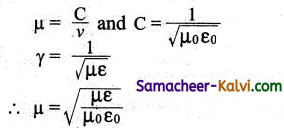
![]()
Question 51.
Match the laws given in column I with Maxwell’s equations in integral form.
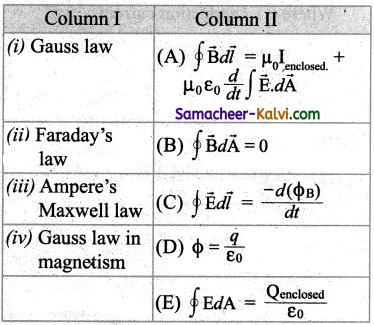
(a) (i) – (C); (ii) – (A); (iii) – (E); (iv) – (D)
(b) (i) – (E); (ii) – (C); (iii) – (A); (iv) – (B)
(c) (d) – (E); (ii) – (D); (iii) – (B); (iv) – (A)
(d) (i) – (D); (ii) – (E); (iii) – (C); (iv) – (A)
Answer:
(b) (i) – (E); (ii) – (C); (iii) – (A); (iv) – (B)
Question 52.
Which one of the following is incorrect statement?
(a) C = \(\frac{1}{\sqrt{\varepsilon_{0} \mu_{0}}}\)
(b) µ = \(\sqrt{\varepsilon_{0} \mu_{0}}\)
(c) µ = \(\sqrt{\varepsilon_{r} \mu_{r}}\)
(d) Ut = \(\frac{1}{2} \varepsilon_{0} \mathrm{E}^{2}\)
Answer:
(b) µ = \(\sqrt{\varepsilon_{0} \mu_{0}}\)
Question 53.
Which one of the following is incorrect?
(a) Electromagnetic waves carry energy
(b) Electromagnetic waves carry current
(c) Electromagnetic waves carry angular momentum
(d) Electromagnetic waves carry momentum
Answer:
(b) Electromagnetic waves carry current
![]()
Question 54.
Any stationary charge produces:
(a) magnetic field
(b) current
(c) displacement current
(d) electric field only
Answer:
(d) electric field only